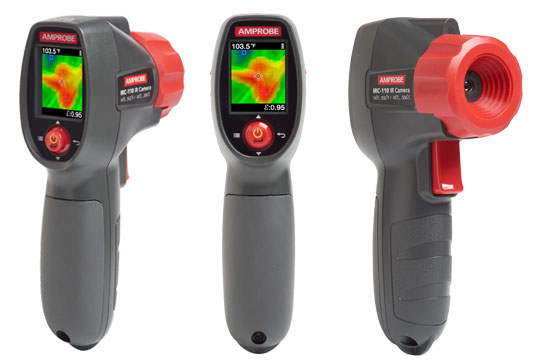
Automotive Diagnostics with the Amprobe IRC-110 & IRC-120
The Amprobe IRC-100 Series of Thermal Cameras are rugged with point-and-shoot functionality to give you a visual heat map image to perform quick and accurate automotive diagnostics for the following systems:
- Air Conditioning
- Heating
- Engine Cooling
- Breaks
- Bearings
- Engine Misfire
- Electrical defrosters and connections
Using a non-contact infrared camera for diagnosis eliminates the danger of coming into contact with hot surfaces, high voltage plug wires or moving parts such as fans, belts or pulleys.
HVAC System
Quickly test overall performance of the HVAC system (heating-ventilation-air conditioning) by measuring temperature at the output vents for heating and AC.
Air Conditioning Troubleshooting
Diagnose problems with AC system by measuring differential temperature at the inlet and outlet points of the expansion valve, condenser and along the AC lines. Compare results with technical data to identify any discrepancies.
Clogged lines will show sudden and significant temperature difference on two sides of the clog, with gas being pressurized on one side of the clog causing heat generation, and then rapidly expanding when passing the clog and because of that rapidly cooling. This method can be used to test the condenser blockage as well.
While scanning the lines, the IRC-100 Series may pinpoint refrigerant leak as the gas flowing outside of the AC system rapidly expands and cools creating thermal image of the leak.
Heating System Troubleshooting
Use the IRC-100 Series to measure temperature at the heater and along all lines to identify if heating system failures are due to coolant circulation problems or blend door issues. Clogged coolant lines will show significant and sudden temperature differences on two sides of the clog, with hot fluid filing entire pipe on one side of the clog and then filing the pipe partially with reduce flow on the other side causing the temperature drop. This method can be used to test the heater blockage as well.
When troubleshooting a low heater output problem, compare the temperature of the heater inlet and outlet hoses where they enter the firewall. Both should be hot, and the inlet hose should be about 20 degrees warmer than the outlet hose. If the outlet hose is not hot, the core is clogged or the heater control valve (if used) is defective. If reverse flushing the core fails to open the blockage, you will have to replace the heater core.
Engine – exhaust manifold temperature
A misfiring cylinder does not produce as much heat as a good one, so the exhaust temperature from a weak cylinder will not be as hot as that from cylinders that are firing normally. To find the misfire, take an IR picture of the exhaust ports on the manifold. Any ports of the cylinders that are misfiring will show lower temperature than others.
This same procedure also works for diesel engines. Comparing exhaust temperatures image can help to identify weak cylinders and diesel injector problems.
Breaks – dragging or sticking calipers
Compare thermal images between left and right front break rotor after stopping a car. Significant temperature difference between rotors may indicate dragging or sticking calipers. Next check thermal image differences between rotors (or drums) of the rear wheels.
Race car teams use an infrared measurement to check brake and tire temperatures to assure proper brake balance and tire loading.
Bearings
Worn out or damaged bearings can generate excessive heat. Compare IR images of wheel bearings between right and left wheel for front and then for rear wheels. A significant temperature difference indicates a problem.
Cooling systems
Inspect the coolant lines and radiator with the IRC-100 Series to check for the coolant flow blockage. Clogged coolant lines will show significant temperature differences on two sides of the clog, with hot fluid filing entire pipe on one side of the clog and then filing the pipe only partially with reduce flow on the other side causing the temperature drop. This method can be used to test the radiator blockage as well.
Scan the surface of the radiator. Temperature readings should decrease evenly from one side to the other on a crossflow radiator, or from top to bottom on a downflow radiator. If you find an area where an image shows abrupt temperature change, the radiator is clogged and needs to be flushed, cleaned or replaced.
Verify proper operation of the thermostat by checking thermal images of the inlet and outlet lines and the temperature of the thermostat housing itself when engine is cold, warming up and at the standard operational temperature. To check the opening temperature of the thermostat, aim infrared camera at the thermostat housing as the engine warms up. The thermostat housing rises in temperature as the engine heats up. When the thermostat opens, the temperature levels off. Compare results with technical specifications of the car.
When a thermostat is stuck in the open position there is minimal difference in temperatures between inlet and outlet hoses during the time when engine warms up. Additionally coolant temperature at the thermostat housing or radiator inlet is unusually low (140 degrees or less), the thermostat needs to be replaced.
Note: The accuracy of an infrared temperature reading of the thermostat opening depends on the reflectivity (emissivity) of the thermostat housing surface.
Electrical Systems
Loose or poor (high resistance) electrical connections restrict a current flow and generate excessive heating. Restricted current may cause various parts of the circuit to malfunction and high temperature may melt connectors and wires or cause fire.
Scan battery terminals, fuses and various electrical connection points to check for excessive heating while the current is flowing by turning on lights, radios, defrosters and other electrical loads.
Diagnose electric defrosters for rear windows, mirrors or windshields. Turn on defrosters and check IR image to identify sections of the defrosters that do not work due to lack of heating element continuity.
